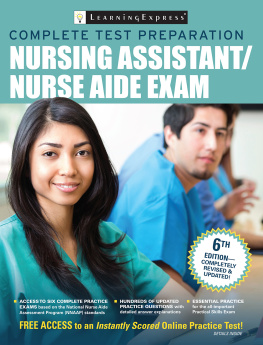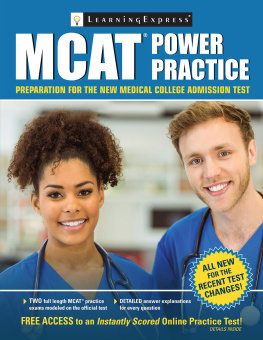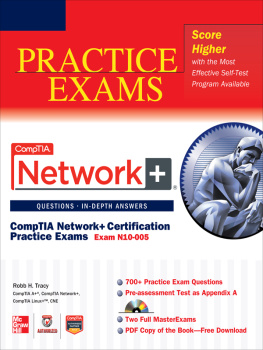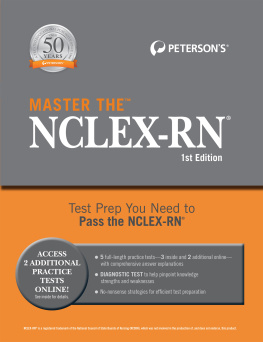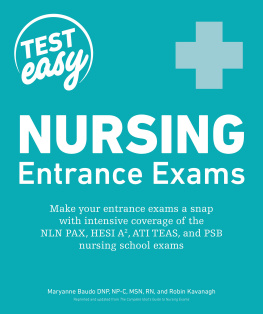CHAPTER 1
the nursing assistant/nurse aide exam
chapter Summary
This chapter introduces you to the certification process for nursing assistants and shows you how to use this book to help you prepare for the exam to become a Certified Nursing Assistant (CNA).
I n this day and age of professionalism, many careers that years ago didnt require much expertise now require not only formal training but also some type of recognized certification. This trend is particularly true for many healthcare professions, including nursing assistant/nurse aide (NA).
Prior to 1987 there were no standards in nursing homes, and the quality of care was in question. As the public began to hear horrible stories in the media of the abuse and mistreatment of residents in nursing homes, the government decided to step in and take action. The result was the Omnibus Budget Reconciliation Act of 1987 (OBRA 87) that implemented standards for nursing homes that receive federal money, such as Medicare or Medicaid. OBRA 87 also emphasized residents rights, registered nurse (RN) presence, improved food and medical services for patients, and better maintenance and housekeeping. Due to these new standards, states now individually regulate the training and testing of Certified Nursing Assistants (CNAs).
The information in this book is based on the national standards for CNAs. Because each state specifies the amount of training and what certification and practical-skills exams CNAs must pass, you will also need to contact state or local agencies to find out about the specific requirements in your state.
Finding Out about Certification Requirements
If you want to become a CNA, the first step is to contact your local community or state health agency to obtain certification requirements. You can find these agencies listed in the blue (government) pages of your phone book or by searching online. You can also contact an employment agency or the healthcare facility you want to work for, since they will often be able to guide you through the training and certification requirements. To give you an idea of what to expect, see Chapter 9 for an outline of some of the current trends in CNA certification.
OBRA 87 laws also require that a state registry be kept for CNAs. Information such as dates of certification, reports of abuse and neglect, and lapse periods are available in these registries. A list of registries by state follows in this chapter.
Education and Training
Healthcare facilities usually require CNAs to have a high school diploma or GED and pass a state-approved training program that consists of anywhere from 75150 hours of training. You can be hired without being certified, but you must receive certification within four months. While the duties of a nursing assistant vary depending on the workplace, the job emphasis is always on the physical and emotional well-being of the patient. While a day in the life of a CNA is not easy, especially when dealing with a difficult patient, most get great satisfaction from their work. Common characteristics for someone considering this profession are dedication, patience, reliability, and compassion. Another key element to the job is the ability to communicate and work well with others. A CNA must also be physically able to perform the job, which often requires standing for a good portion of an 8- to 12-hour day and lifting and moving objects and equipment. As a CNA, your training will consist of learning to perform the following basic duties:
c ommunicating with the patient and others on the job
b athing and dressing the patient (general skin care and hygiene)
helping patients out of bed
setting up and storing medical equipment
taking vital signspulse, blood pressure, temperature, and respiration
f eeding the patient
changing bed linens
cleaning bedpans and measuring urine output
ambulating patients
Career Outlook and Earning Potential
The nursing assistant profession, on the whole, is growing faster than average. Nurse aides held more than 1.5 million jobs in 2015 and that number is expected to increase by 17% through 2024. While job prospects are good, the salaries tend to be low. Median hourly pay is $12 per hour, but varies depending on which part of the country you live in. Salaries in the Northeast are highest while the South is lower paying. If you have five years of experience or more, your pay increases by a few dollars per hour. Paid holidays, hospital and medical benefits, extra pay for overtime, and pension plans are available to many hospital and some nursing home employees.
Once you know what you have to do to be certified in your state, you can begin to plan your CNA study program. Go to a local job-counseling center, state employment agency, or private healthcare job- placement service to get information about how to get the training you need to become a CNA. Many healthcare agencies will provide you with the training you need. Or you may be able to prepare on your own and simply demonstrate your competence by taking a written exam, a practical exam, or both. Whether youre involved in a training class or working on your own, you should be using textbooks and other materials that will train you in the most important skills a CNA needs. Such books will be available in public libraries and college bookstores; job-search agencies may also have some supplemental materials available.
How to Use This Book
Many state and local agencies require a written exam consisting of approximately 70 multiple-choice questions as part of the certification process for CNAs. This book contains five practice written exams based on the national standards that contain questions about all the skills you will use as a CNA. The written portion of the nursing assistant exam consists of multiple-choice questions, while the clinical portion has the test-taker performing five on-the-job skills. Some of the skills tested include:
personal care skills, such as client bathing, grooming, dressing, toileting, skin care, and nutrition
basic nursing skills, such as providing a safe and clean environment, recognizing abnormal signs or symptoms of diseases and conditions, communicating with clients, and understanding basic principles of infection and control
mental health and social service needs, such as psychosocial characteristics of populations, identification of developmental tasks associated with aging, and behavior management
basic restorative devices, such as use of assistive devices, range of motion, client transfer, bowel and bladder training, and care and use of prosthetic devices
clients rights, such as privacy, grievances, client and family group participation, physical and chemical restraints, and personal possessions
employability skills, such as acquiring and maintaining a job
Even if your state or agency doesnt require a written exam, youll find that these practice exams are a valuable way to review and solidify your skills.
Once you have completed your course of study, you are ready to take the first practice exam in this book. Each practice exam contains 70 multiple-choice questions on all aspects of the job. Allow yourself enough time to complete the entire exam at one sitting, approximately two-and-a-half hours.
Each practice exam has an answer key at the end, which not only tells you the right answer but also explains why that answer is right. In general, you should count yourself successful when you can score at least 75%. If you dont get that score on the first practice exam, dont panic! First, review the answer explanations to see where you went wrong. Then, see which areas you did well in and which areas gave you more trouble. Go back to your textbook or other training materials to review your weakest areas. Then take the second practice exam. You should find that your score improves. Continue this processreviewing, taking a practice exam, more reviewuntil youve completed all five practice exams in this book. That way youll be well prepared for any state certification exam you may have to take.
Next page
